PSY393 Psychology: The Developing Mind - Critical Analysis 2020 TJA
VerifiedAdded on 2022/08/16
|8
|1831
|461
Homework Assignment
AI Summary
This assignment requires a critical analysis of the study by Elashi and Ameera (2019) on skepticism across cultures, specifically examining the ability of Jordanian and U.S. children to doubt and reject distorted claims. The assignment instructs the student to evaluate the study's findings in relation to the essay topic: 'As children develop, they naturally lose their gullibility and become more skeptical, critical thinkers.' The student is asked to identify relevant findings, assess the study's methodological strengths and weaknesses, and draw conclusions about the essay topic based on the provided research. The student highlights the study's strengths, such as the cross-cultural comparison and the use of different question types to assess skepticism. The study revealed that older children showed advanced methods in perceiving questions, and that older children had a hard time letting go of biases when it came to best friend and worst enemy. The student also notes a minor weakness in the potential for researcher bias. The student concludes that children do lose gullibility with age, but cultural factors may influence their ability to verbalize reasons for skepticism, which is a gap in the study. Overall, the assignment aims to develop critical thinking skills and the ability to evaluate research evidence within the context of a specific psychological topic.
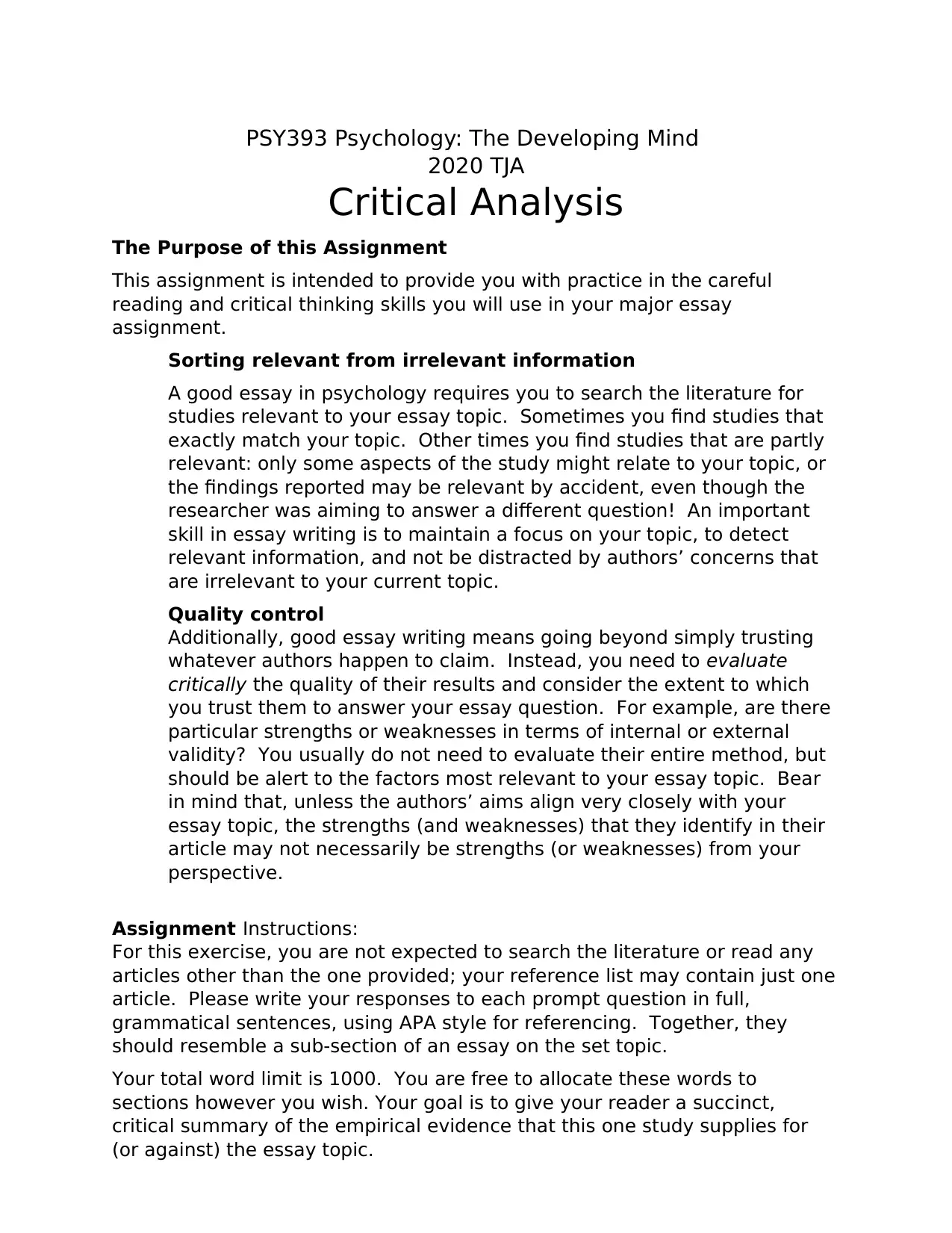
PSY393 Psychology: The Developing Mind
2020 TJA
Critical Analysis
The Purpose of this Assignment
This assignment is intended to provide you with practice in the careful
reading and critical thinking skills you will use in your major essay
assignment.
Sorting relevant from irrelevant information
A good essay in psychology requires you to search the literature for
studies relevant to your essay topic. Sometimes you find studies that
exactly match your topic. Other times you find studies that are partly
relevant: only some aspects of the study might relate to your topic, or
the findings reported may be relevant by accident, even though the
researcher was aiming to answer a different question! An important
skill in essay writing is to maintain a focus on your topic, to detect
relevant information, and not be distracted by authors’ concerns that
are irrelevant to your current topic.
Quality control
Additionally, good essay writing means going beyond simply trusting
whatever authors happen to claim. Instead, you need to evaluate
critically the quality of their results and consider the extent to which
you trust them to answer your essay question. For example, are there
particular strengths or weaknesses in terms of internal or external
validity? You usually do not need to evaluate their entire method, but
should be alert to the factors most relevant to your essay topic. Bear
in mind that, unless the authors’ aims align very closely with your
essay topic, the strengths (and weaknesses) that they identify in their
article may not necessarily be strengths (or weaknesses) from your
perspective.
Assignment Instructions:
For this exercise, you are not expected to search the literature or read any
articles other than the one provided; your reference list may contain just one
article. Please write your responses to each prompt question in full,
grammatical sentences, using APA style for referencing. Together, they
should resemble a sub-section of an essay on the set topic.
Your total word limit is 1000. You are free to allocate these words to
sections however you wish. Your goal is to give your reader a succinct,
critical summary of the empirical evidence that this one study supplies for
(or against) the essay topic.
2020 TJA
Critical Analysis
The Purpose of this Assignment
This assignment is intended to provide you with practice in the careful
reading and critical thinking skills you will use in your major essay
assignment.
Sorting relevant from irrelevant information
A good essay in psychology requires you to search the literature for
studies relevant to your essay topic. Sometimes you find studies that
exactly match your topic. Other times you find studies that are partly
relevant: only some aspects of the study might relate to your topic, or
the findings reported may be relevant by accident, even though the
researcher was aiming to answer a different question! An important
skill in essay writing is to maintain a focus on your topic, to detect
relevant information, and not be distracted by authors’ concerns that
are irrelevant to your current topic.
Quality control
Additionally, good essay writing means going beyond simply trusting
whatever authors happen to claim. Instead, you need to evaluate
critically the quality of their results and consider the extent to which
you trust them to answer your essay question. For example, are there
particular strengths or weaknesses in terms of internal or external
validity? You usually do not need to evaluate their entire method, but
should be alert to the factors most relevant to your essay topic. Bear
in mind that, unless the authors’ aims align very closely with your
essay topic, the strengths (and weaknesses) that they identify in their
article may not necessarily be strengths (or weaknesses) from your
perspective.
Assignment Instructions:
For this exercise, you are not expected to search the literature or read any
articles other than the one provided; your reference list may contain just one
article. Please write your responses to each prompt question in full,
grammatical sentences, using APA style for referencing. Together, they
should resemble a sub-section of an essay on the set topic.
Your total word limit is 1000. You are free to allocate these words to
sections however you wish. Your goal is to give your reader a succinct,
critical summary of the empirical evidence that this one study supplies for
(or against) the essay topic.
Paraphrase This Document
Need a fresh take? Get an instant paraphrase of this document with our AI Paraphraser

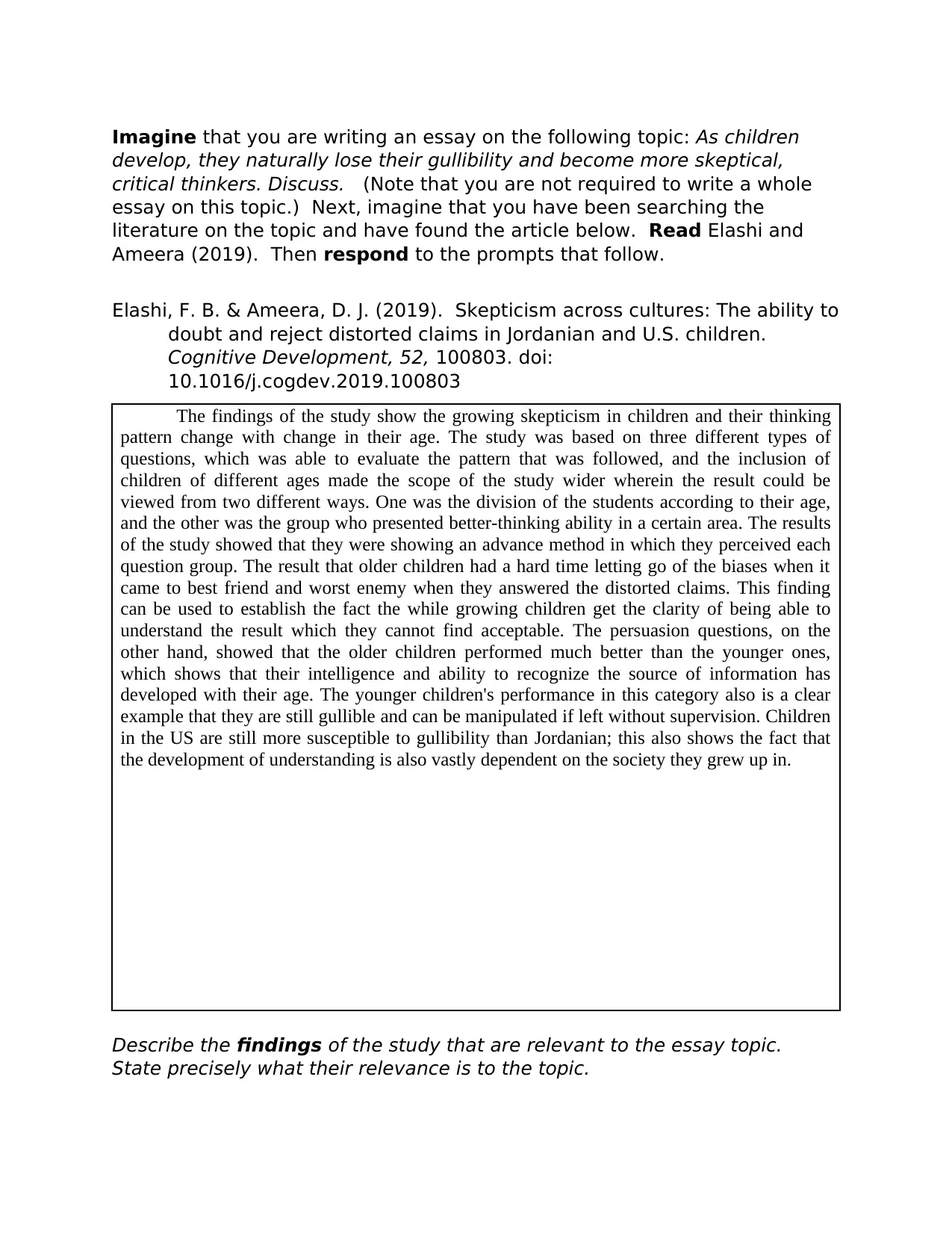
Imagine that you are writing an essay on the following topic: As children
develop, they naturally lose their gullibility and become more skeptical,
critical thinkers. Discuss. (Note that you are not required to write a whole
essay on this topic.) Next, imagine that you have been searching the
literature on the topic and have found the article below. Read Elashi and
Ameera (2019). Then respond to the prompts that follow.
Elashi, F. B. & Ameera, D. J. (2019). Skepticism across cultures: The ability to
doubt and reject distorted claims in Jordanian and U.S. children.
Cognitive Development, 52, 100803. doi:
10.1016/j.cogdev.2019.100803
The findings of the study show the growing skepticism in children and their thinking
pattern change with change in their age. The study was based on three different types of
questions, which was able to evaluate the pattern that was followed, and the inclusion of
children of different ages made the scope of the study wider wherein the result could be
viewed from two different ways. One was the division of the students according to their age,
and the other was the group who presented better-thinking ability in a certain area. The results
of the study showed that they were showing an advance method in which they perceived each
question group. The result that older children had a hard time letting go of the biases when it
came to best friend and worst enemy when they answered the distorted claims. This finding
can be used to establish the fact the while growing children get the clarity of being able to
understand the result which they cannot find acceptable. The persuasion questions, on the
other hand, showed that the older children performed much better than the younger ones,
which shows that their intelligence and ability to recognize the source of information has
developed with their age. The younger children's performance in this category also is a clear
example that they are still gullible and can be manipulated if left without supervision. Children
in the US are still more susceptible to gullibility than Jordanian; this also shows the fact that
the development of understanding is also vastly dependent on the society they grew up in.
Describe the findings of the study that are relevant to the essay topic.
State precisely what their relevance is to the topic.
develop, they naturally lose their gullibility and become more skeptical,
critical thinkers. Discuss. (Note that you are not required to write a whole
essay on this topic.) Next, imagine that you have been searching the
literature on the topic and have found the article below. Read Elashi and
Ameera (2019). Then respond to the prompts that follow.
Elashi, F. B. & Ameera, D. J. (2019). Skepticism across cultures: The ability to
doubt and reject distorted claims in Jordanian and U.S. children.
Cognitive Development, 52, 100803. doi:
10.1016/j.cogdev.2019.100803
The findings of the study show the growing skepticism in children and their thinking
pattern change with change in their age. The study was based on three different types of
questions, which was able to evaluate the pattern that was followed, and the inclusion of
children of different ages made the scope of the study wider wherein the result could be
viewed from two different ways. One was the division of the students according to their age,
and the other was the group who presented better-thinking ability in a certain area. The results
of the study showed that they were showing an advance method in which they perceived each
question group. The result that older children had a hard time letting go of the biases when it
came to best friend and worst enemy when they answered the distorted claims. This finding
can be used to establish the fact the while growing children get the clarity of being able to
understand the result which they cannot find acceptable. The persuasion questions, on the
other hand, showed that the older children performed much better than the younger ones,
which shows that their intelligence and ability to recognize the source of information has
developed with their age. The younger children's performance in this category also is a clear
example that they are still gullible and can be manipulated if left without supervision. Children
in the US are still more susceptible to gullibility than Jordanian; this also shows the fact that
the development of understanding is also vastly dependent on the society they grew up in.
Describe the findings of the study that are relevant to the essay topic.
State precisely what their relevance is to the topic.
⊘ This is a preview!⊘
Do you want full access?
Subscribe today to unlock all pages.

Trusted by 1+ million students worldwide
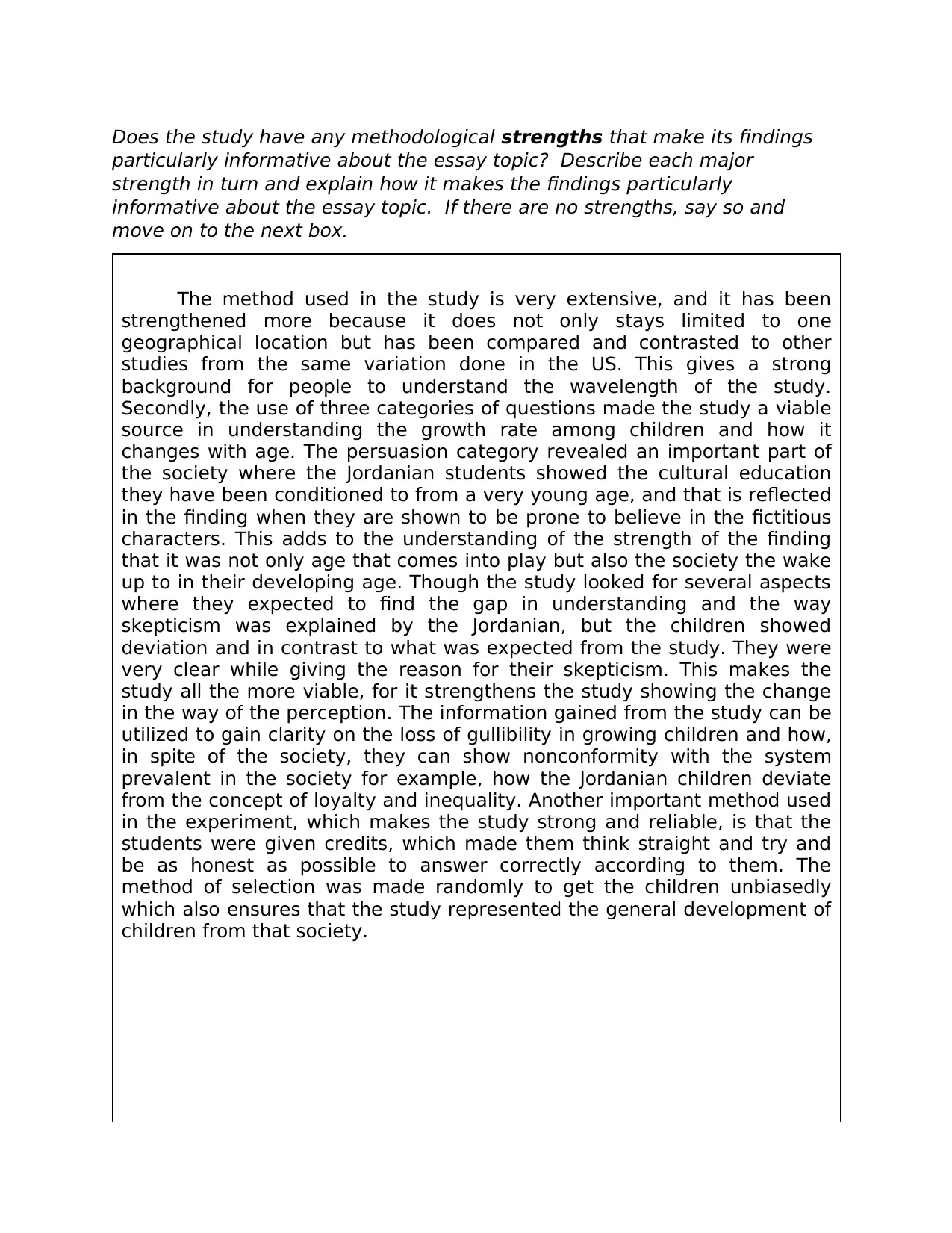
Does the study have any methodological strengths that make its findings
particularly informative about the essay topic? Describe each major
strength in turn and explain how it makes the findings particularly
informative about the essay topic. If there are no strengths, say so and
move on to the next box.
The method used in the study is very extensive, and it has been
strengthened more because it does not only stays limited to one
geographical location but has been compared and contrasted to other
studies from the same variation done in the US. This gives a strong
background for people to understand the wavelength of the study.
Secondly, the use of three categories of questions made the study a viable
source in understanding the growth rate among children and how it
changes with age. The persuasion category revealed an important part of
the society where the Jordanian students showed the cultural education
they have been conditioned to from a very young age, and that is reflected
in the finding when they are shown to be prone to believe in the fictitious
characters. This adds to the understanding of the strength of the finding
that it was not only age that comes into play but also the society the wake
up to in their developing age. Though the study looked for several aspects
where they expected to find the gap in understanding and the way
skepticism was explained by the Jordanian, but the children showed
deviation and in contrast to what was expected from the study. They were
very clear while giving the reason for their skepticism. This makes the
study all the more viable, for it strengthens the study showing the change
in the way of the perception. The information gained from the study can be
utilized to gain clarity on the loss of gullibility in growing children and how,
in spite of the society, they can show nonconformity with the system
prevalent in the society for example, how the Jordanian children deviate
from the concept of loyalty and inequality. Another important method used
in the experiment, which makes the study strong and reliable, is that the
students were given credits, which made them think straight and try and
be as honest as possible to answer correctly according to them. The
method of selection was made randomly to get the children unbiasedly
which also ensures that the study represented the general development of
children from that society.
particularly informative about the essay topic? Describe each major
strength in turn and explain how it makes the findings particularly
informative about the essay topic. If there are no strengths, say so and
move on to the next box.
The method used in the study is very extensive, and it has been
strengthened more because it does not only stays limited to one
geographical location but has been compared and contrasted to other
studies from the same variation done in the US. This gives a strong
background for people to understand the wavelength of the study.
Secondly, the use of three categories of questions made the study a viable
source in understanding the growth rate among children and how it
changes with age. The persuasion category revealed an important part of
the society where the Jordanian students showed the cultural education
they have been conditioned to from a very young age, and that is reflected
in the finding when they are shown to be prone to believe in the fictitious
characters. This adds to the understanding of the strength of the finding
that it was not only age that comes into play but also the society the wake
up to in their developing age. Though the study looked for several aspects
where they expected to find the gap in understanding and the way
skepticism was explained by the Jordanian, but the children showed
deviation and in contrast to what was expected from the study. They were
very clear while giving the reason for their skepticism. This makes the
study all the more viable, for it strengthens the study showing the change
in the way of the perception. The information gained from the study can be
utilized to gain clarity on the loss of gullibility in growing children and how,
in spite of the society, they can show nonconformity with the system
prevalent in the society for example, how the Jordanian children deviate
from the concept of loyalty and inequality. Another important method used
in the experiment, which makes the study strong and reliable, is that the
students were given credits, which made them think straight and try and
be as honest as possible to answer correctly according to them. The
method of selection was made randomly to get the children unbiasedly
which also ensures that the study represented the general development of
children from that society.
Paraphrase This Document
Need a fresh take? Get an instant paraphrase of this document with our AI Paraphraser

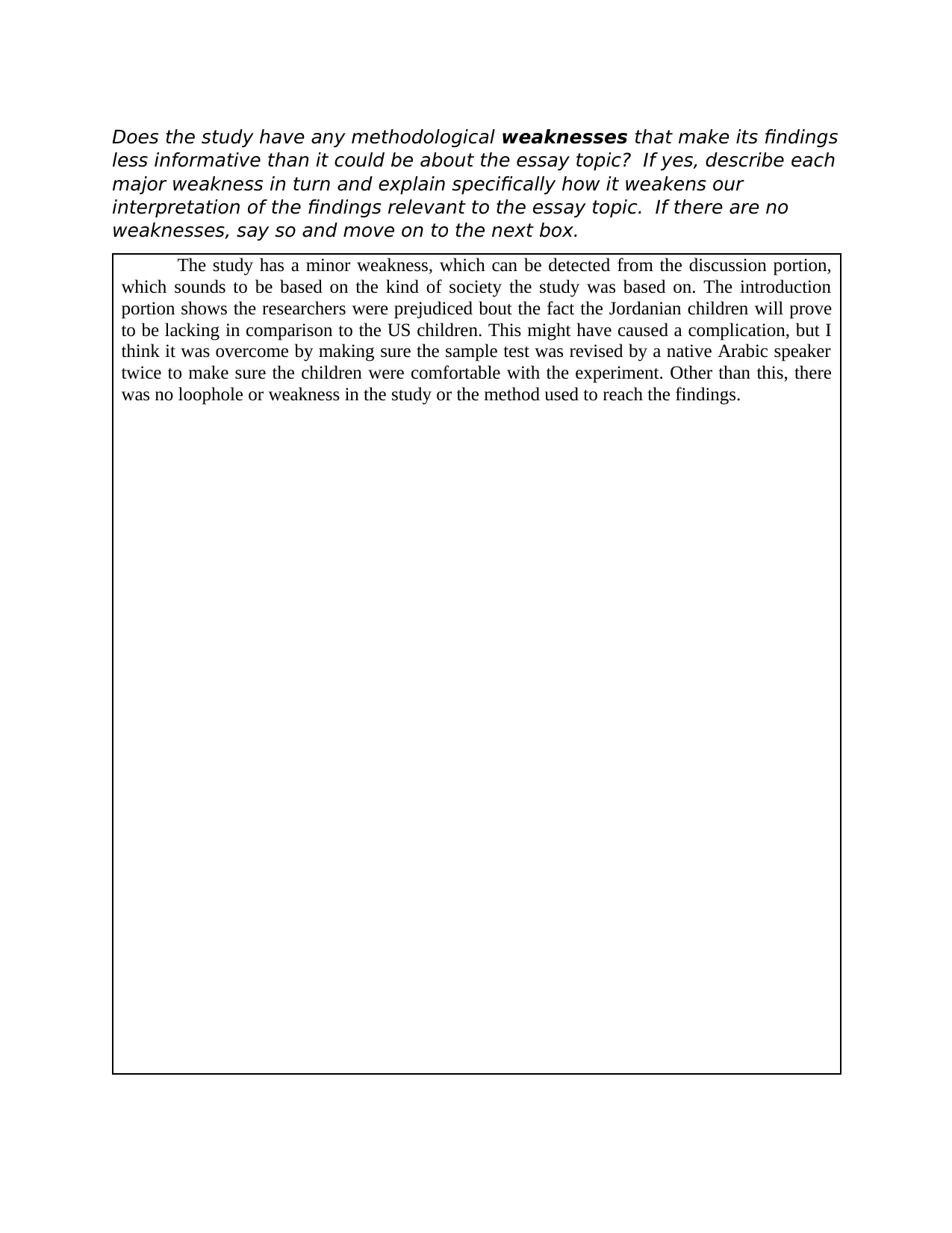
Does the study have any methodological weaknesses that make its findings
less informative than it could be about the essay topic? If yes, describe each
major weakness in turn and explain specifically how it weakens our
interpretation of the findings relevant to the essay topic. If there are no
weaknesses, say so and move on to the next box.
The study has a minor weakness, which can be detected from the discussion portion,
which sounds to be based on the kind of society the study was based on. The introduction
portion shows the researchers were prejudiced bout the fact the Jordanian children will prove
to be lacking in comparison to the US children. This might have caused a complication, but I
think it was overcome by making sure the sample test was revised by a native Arabic speaker
twice to make sure the children were comfortable with the experiment. Other than this, there
was no loophole or weakness in the study or the method used to reach the findings.
less informative than it could be about the essay topic? If yes, describe each
major weakness in turn and explain specifically how it weakens our
interpretation of the findings relevant to the essay topic. If there are no
weaknesses, say so and move on to the next box.
The study has a minor weakness, which can be detected from the discussion portion,
which sounds to be based on the kind of society the study was based on. The introduction
portion shows the researchers were prejudiced bout the fact the Jordanian children will prove
to be lacking in comparison to the US children. This might have caused a complication, but I
think it was overcome by making sure the sample test was revised by a native Arabic speaker
twice to make sure the children were comfortable with the experiment. Other than this, there
was no loophole or weakness in the study or the method used to reach the findings.
⊘ This is a preview!⊘
Do you want full access?
Subscribe today to unlock all pages.

Trusted by 1+ million students worldwide
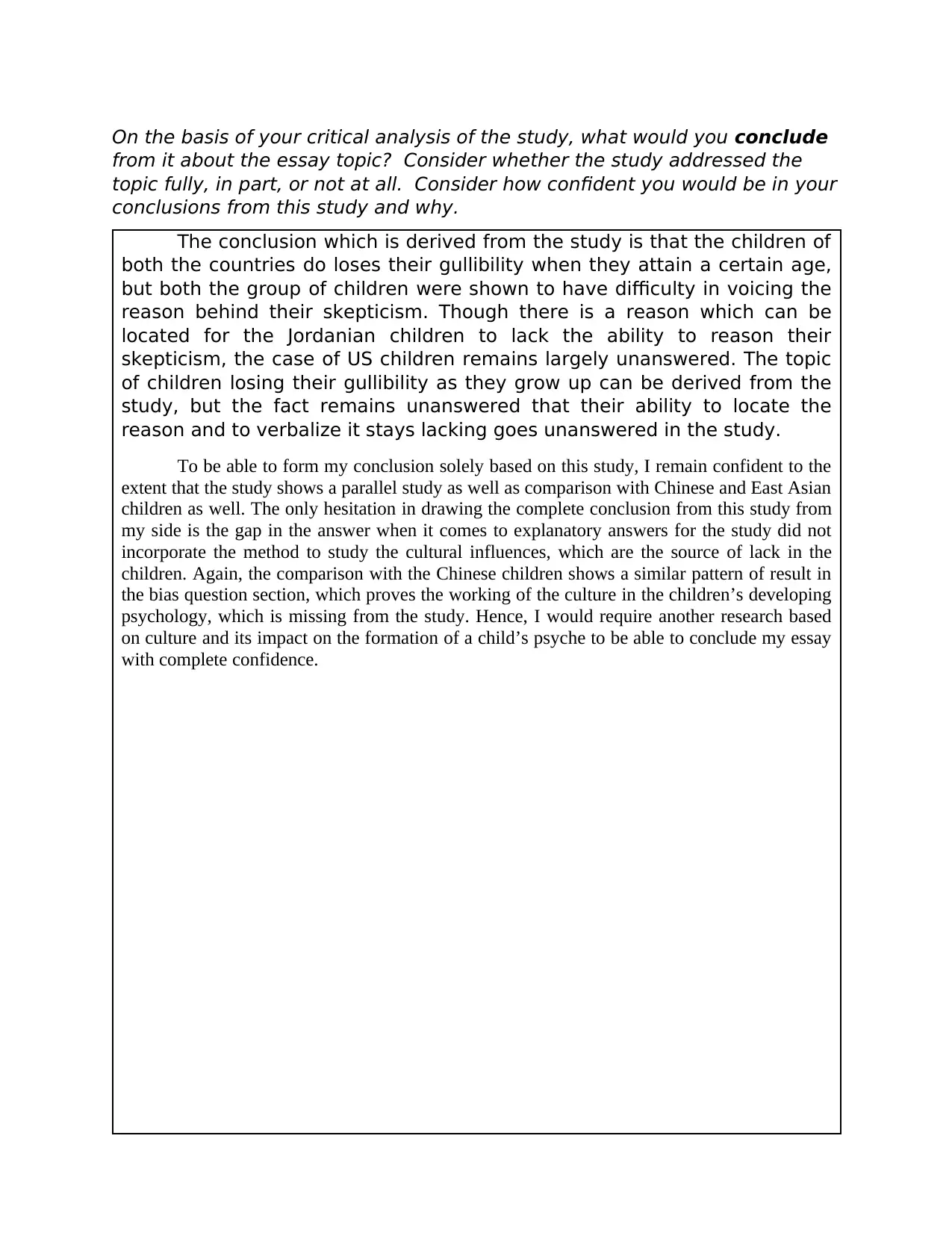
On the basis of your critical analysis of the study, what would you conclude
from it about the essay topic? Consider whether the study addressed the
topic fully, in part, or not at all. Consider how confident you would be in your
conclusions from this study and why.
The conclusion which is derived from the study is that the children of
both the countries do loses their gullibility when they attain a certain age,
but both the group of children were shown to have difficulty in voicing the
reason behind their skepticism. Though there is a reason which can be
located for the Jordanian children to lack the ability to reason their
skepticism, the case of US children remains largely unanswered. The topic
of children losing their gullibility as they grow up can be derived from the
study, but the fact remains unanswered that their ability to locate the
reason and to verbalize it stays lacking goes unanswered in the study.
To be able to form my conclusion solely based on this study, I remain confident to the
extent that the study shows a parallel study as well as comparison with Chinese and East Asian
children as well. The only hesitation in drawing the complete conclusion from this study from
my side is the gap in the answer when it comes to explanatory answers for the study did not
incorporate the method to study the cultural influences, which are the source of lack in the
children. Again, the comparison with the Chinese children shows a similar pattern of result in
the bias question section, which proves the working of the culture in the children’s developing
psychology, which is missing from the study. Hence, I would require another research based
on culture and its impact on the formation of a child’s psyche to be able to conclude my essay
with complete confidence.
from it about the essay topic? Consider whether the study addressed the
topic fully, in part, or not at all. Consider how confident you would be in your
conclusions from this study and why.
The conclusion which is derived from the study is that the children of
both the countries do loses their gullibility when they attain a certain age,
but both the group of children were shown to have difficulty in voicing the
reason behind their skepticism. Though there is a reason which can be
located for the Jordanian children to lack the ability to reason their
skepticism, the case of US children remains largely unanswered. The topic
of children losing their gullibility as they grow up can be derived from the
study, but the fact remains unanswered that their ability to locate the
reason and to verbalize it stays lacking goes unanswered in the study.
To be able to form my conclusion solely based on this study, I remain confident to the
extent that the study shows a parallel study as well as comparison with Chinese and East Asian
children as well. The only hesitation in drawing the complete conclusion from this study from
my side is the gap in the answer when it comes to explanatory answers for the study did not
incorporate the method to study the cultural influences, which are the source of lack in the
children. Again, the comparison with the Chinese children shows a similar pattern of result in
the bias question section, which proves the working of the culture in the children’s developing
psychology, which is missing from the study. Hence, I would require another research based
on culture and its impact on the formation of a child’s psyche to be able to conclude my essay
with complete confidence.
Paraphrase This Document
Need a fresh take? Get an instant paraphrase of this document with our AI Paraphraser
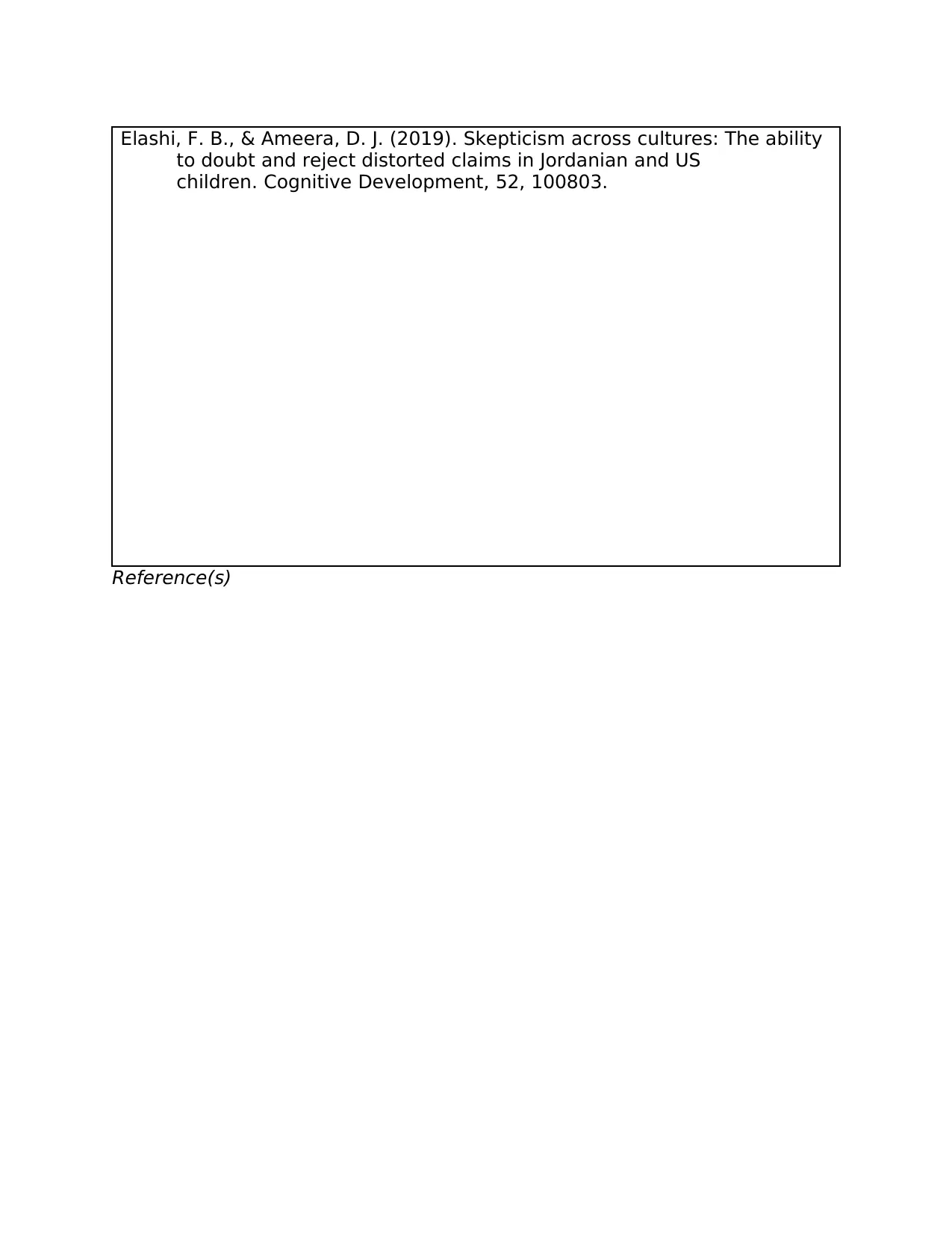
Elashi, F. B., & Ameera, D. J. (2019). Skepticism across cultures: The ability
to doubt and reject distorted claims in Jordanian and US
children. Cognitive Development, 52, 100803.
Reference(s)
to doubt and reject distorted claims in Jordanian and US
children. Cognitive Development, 52, 100803.
Reference(s)
1 out of 8
Related Documents
Your All-in-One AI-Powered Toolkit for Academic Success.
+13062052269
info@desklib.com
Available 24*7 on WhatsApp / Email
![[object Object]](/_next/static/media/star-bottom.7253800d.svg)
Unlock your academic potential
Copyright © 2020–2025 A2Z Services. All Rights Reserved. Developed and managed by ZUCOL.





